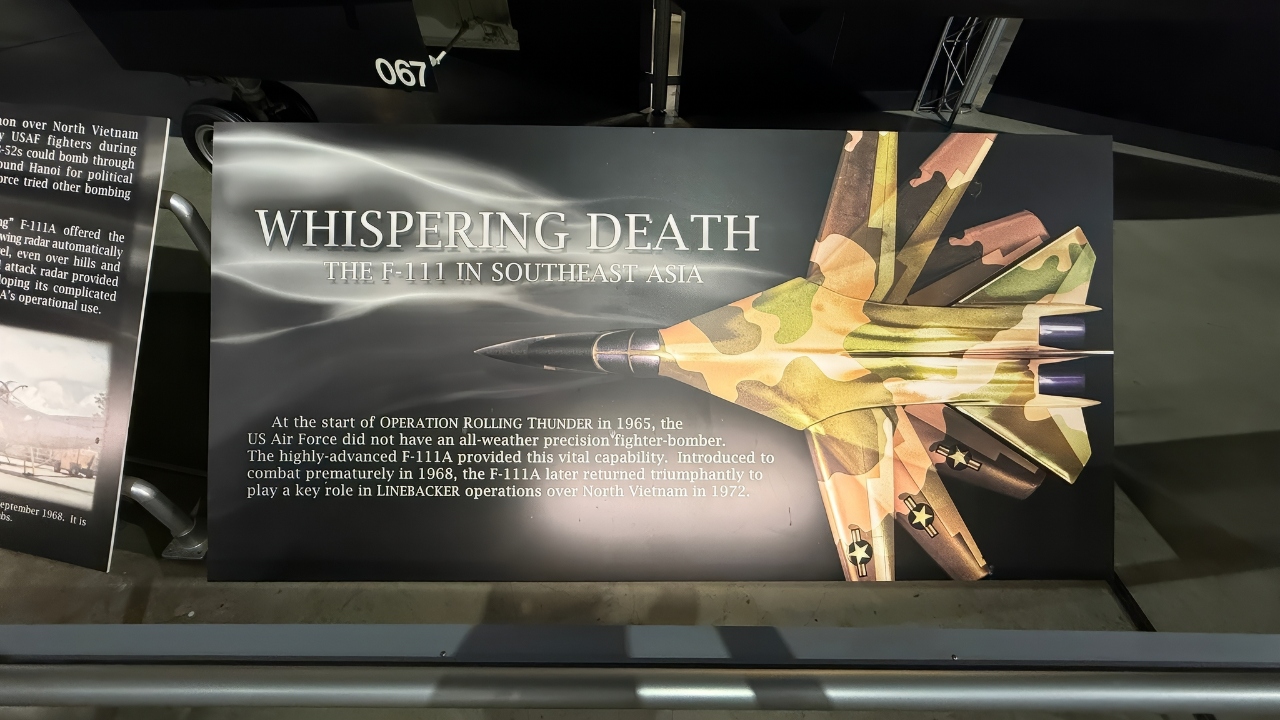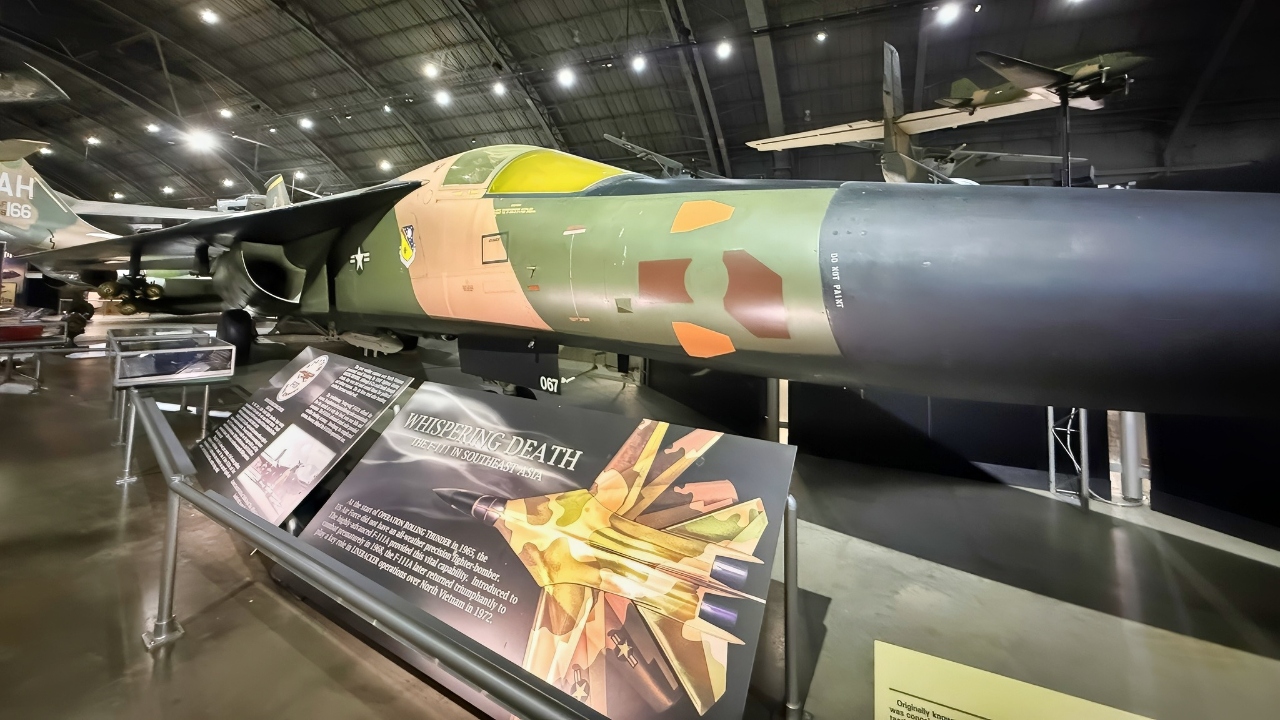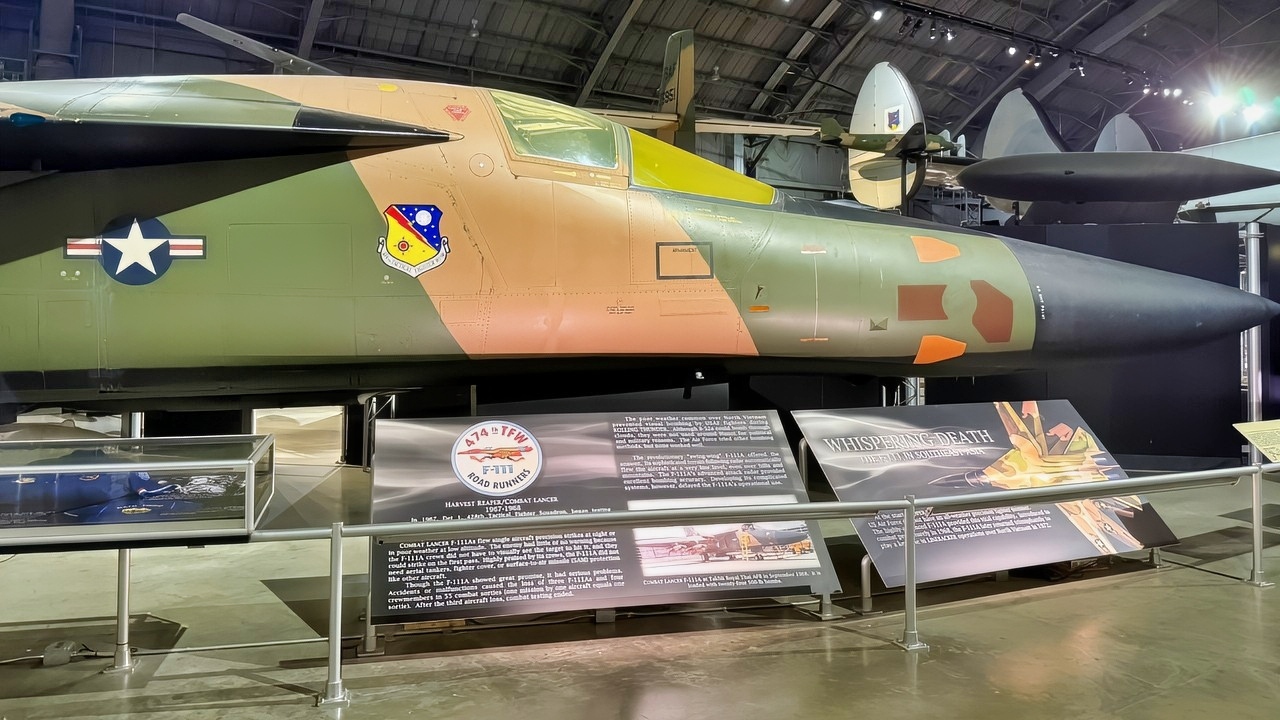Key Points and Summary – The F-111 Aardvark, a 1960s supersonic jet, was the controversial product of Defense Secretary Robert McNamara’s “Tactical Fighter Experimental” (TFX) program, which tried to force one airframe to serve both the Air Force and Navy.
-The concept failed spectacularly for the Navy, whose admirals and pilots despised the F-111B variant as an overweight, underpowered “flying Edsel.”

F-111 Photo from USAF Museum in Dayton. Image Credit: National Security Journal.

USAF Museum F-111 National Security Journal New Photo.
-The Navy version was quickly canceled, paving the way for the F-14.
-However, the Air Force matured its F-111 variants into “exceptional” low-level strike aircraft that served for 30 years, proving highly effective in combat operations like El Dorado Canyon and Desert Storm.
The F-111 Aardvark Was Like No Other
The F-111, known as the Aardvark, was developed in the 1960s, following the U-2 spyplane shootdown incident in 1960. Developed by General Dynamics for the Air Force, the Aardvark had a relatively short life, although it has become a favorite of aviation buffs.
According to a Simple Flying story, published in late 2024, the Aardvark had a unique development story.
The F-111 Aardvark Develops
Then-Secretary of Defense Robert S. McNamara, who had worked for the Ford Motor Company before entering government, “wanted to apply automobile manufacturing ideas like different models from the same frame to fighter jet construction.”
This strategy led to the Tactical Fighter Experimental (TFX) program, which brought the Navy and the Air Force together to procure aircraft. However, per Simple Flying, “combining the two missions into one flying platform in an era before precision bombing did not conclude well.”
The two branches, it turned out, had different goals at the time.

F-111 In USAF Museum July 2025 NSJ Image Taken by Harry J. Kazianis.
“While the USAF wanted TFX to fly fast for long distances plus make a low-level supersonic bombing run, the USN wanted TFX to fly far and loiter at altitude before lobbing long-range air-to-air missiles and potentially dogfighting.”
There was heavy competition for the contract, which was ultimately won by General Dynamics, despite what Smithsonian magazine called “strenuous objections from a military selection board that favored a Boeing proposal.”
McNamara later decided that the Air Force would manage the project, leading to design choices the Navy would not have approved.
This led to the F-111B, the Navy version, which quickly ran into trouble. Issues were discovered in the engines after its first flight in 1965.
“A lot of politics was involved with that airplane. It was a weight around everyone’s shoulders. Pilots didn’t want it,” Retired Navy Captain Joe Brantuas said, per Simply Flying.
And while the F-111B was able to carry the AIM-54 Phoenix long-range air-to-air missile, that proved not to be enough.
“Senator, there isn’t enough power in all Christendom to make that airplane what we want,” Vice Admiral Tom Connolly told one senator. The Tomcat, which was effectively the jet’s successor, was named for Connolly.
When McNamara left the Pentagon in 1968, the project lost its most powerful backer.
The Legacy of the Aardvark
The jet is one people still argue about to this day, including in a 2018 Smithsonian magazine article titled “Was the Navy’s F-111 Really That Bad?”
Critics had described the F-111 as a “flying Edsel,” while one pilot described it as “the worst aircraft I had ever flown.”
George Marrett, a pilot, told the Smithsonian magazine that the F-111 “took a terrible toll on test pilots,” with multiple pilots he knew killed on test flights. He even crashed himself in 1969.
While Marrett, in his book, had negative things to say about the F-111, he appreciated the jet for “perfecting the Phoenix missile and its associated AN/AWG-9 radar system.”
“I wouldn’t want to maneuver one against a fighter,” Marrett told Smithsonian magazine. “But purely as an interceptor, it would have done well against bombers and cruise missiles.”
While the Navy was strongly opposed to the project, it was well used by the Air Force and had a longer-than-expected life.
“Despite an inauspicious combat introduction over Southeast Asia in 1968, Air Force F-111s would mature into exceptional attack aircraft. Indeed, different versions of ‘McNamara’s airplane’ went on to serve for 30 years, with EF-111 electronic warfare variants deployed to the Persian Gulf as late as 1998,” Smithsonian magazine said of the jet. “The Australian air force picked up two dozen more, and kept the F-111 as its main attack airplane until 2010.” Australia, per a We Are the Mighty story earlier this month, has taken to burying its F-111 jets.

F-111. Image Credit: Creative Commons.
However, as Simple Flying points out, the F-35’s procurement was much more successful, especially with “three US flying services, and no less than 20 nations purchasing the F-35.”
A Memorable Flight
The Aviation Geek Club this week shared a story about the time an F-111 pilot exceeded Mach 2 at 50,000 feet.
Paul Ghiron, a pilot who flew the jet, told the story on Quora about going that speed on a “Functional Check Flight.”
“I only saw that speed once in the F-111 since most of our missions were low-level dash where we could only get up to about Mach 1.3 – 1.4 depending on how the engines were tweaked,” he wrote. “That is really fast down low at sea level, where basically no one could catch us, and we could see the shock wave as it traveled over the water.”
They reached Mach 2.15, he said, at which point the five-minute countdown timer was triggered, and they slowed down, “rather than have the maintenance guys give us hell for bubbling the skin.”
‘So how did it feel at that speed?” he concluded. “Not much different than at slower speeds, other than at that altitude, the sky is a dark blue.”
The story also said that, while the F-111 was long known as the “Aardvark,” it did not officially receive that name until its retirement.
To the U.K.
Back in September, the website for the U.S. Air Force in Europe and Africa commemorated the 55th anniversary of the F-111 Aardvarks’ arrival in the U.K., which marked the start of what was described as “a new era in European AirPower.”
“It was the first production aircraft with variable-sweep wings, giving pilots the ability to adapt wing position to maximize performance during high-speed, low-level flight,” the Air Force article said. “The F-111 entered service in 1967, with early combat use in Vietnam, and later proved itself in major operations such as El Dorado Canyon in 1986 and Desert Storm in 1991.”
The F-111 was retired in Europe in 1992, which the Air Force attributed to “the end of the Cold War and the high maintenance costs.” But its legacy remains.
“From the F-111’s variable wings to today’s fifth-generation fighters and agile operations, USAFE has continually adapted to ensure that American airpower remains forward, ready, and reliable for its allies,” the Air Force said.
About the Author: Stephen Silver
Stephen Silver is an award-winning journalist, essayist, and film critic, and contributor to the Philadelphia Inquirer, the Jewish Telegraphic Agency, Broad Street Review, and Splice Today. The co-founder of the Philadelphia Film Critics Circle, Stephen lives in suburban Philadelphia with his wife and two sons. For over a decade, Stephen has authored thousands of articles that focus on politics, national security, technology, and the economy. Follow him on X (formerly Twitter) at @StephenSilver, and subscribe to his Substack newsletter.
More Military
Forget the F-35 of F-47: A 7th Generation Fighter Is Possible
$500 Drones are Destroying $10,000,000 NATO Tanks in Ukraine War
The Mach 2.2 F-4 Phantom II Fighter Has a Message for Every Air Force on Earth
China’s White Emperor ‘NGAD’ Stealth Fighter Summed Up in 2 Words











Krystal cane
October 30, 2025 at 1:49 pm
Is the message they have been out of service for how many years.
Krystal cane
October 30, 2025 at 1:51 pm
By the way that’s a F111b used by the Navy. You’d think that at least get the Air Force version of the picture 🤣😃🤣🤣
William Eades
November 2, 2025 at 7:00 pm
As an F111 Avionics Tech my entire career, you might want to look at the FB111A flown by SAC. Our shoulder patches stated MACH 2.5+ and they meant it.
George kamburoff
November 9, 2025 at 12:46 pm
The entire production of this aircraft was pure politics. Those of us who worked on the first four did not like them. Poor build quality was the major complaint.
When it came time for congress to approve their purchase, they kept all of us away one night while they let members of congress sit in the seats and pretend.
I am glad it turned out to have purpose.